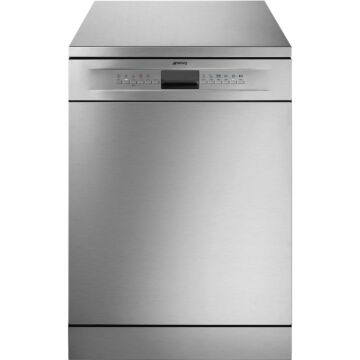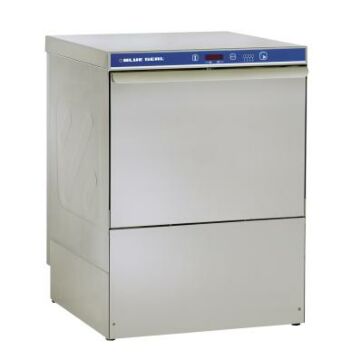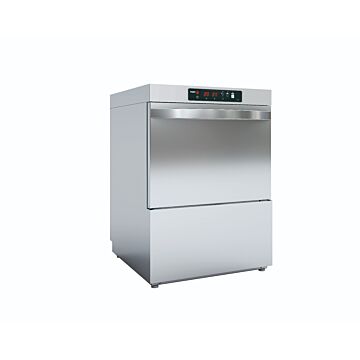For Christmas opening times click here for more details.
Shop 2 stores as 1 | Shared Search, Account & Cart
Checkout using your account
Checkout as a new customer
Creating an account has many benefits:
- See order and shipping status
- Track order history
- Check out faster
Commercial Dishwashers
Commercial dishwashers are indispensable assets for any bustling restaurant or catering and hospitality business. FFD offer a choice of sizes, styles, and capacities, ensuring every business finds the ideal commercial warewashers to meet their specific requirements. With options ranging from compact undercounter models to expansive pass-through hood type set-ups and high capacity but efficient conveyor designs, there is a perfect match for every scale of operation.
Need help selecting the ideal equipment?

- Baskets Supplied 3
- Colour Stainless Steel
- Doors Drop Down
- Footing Feet
- SKU LVS344PM Show More
Minimum order value £1000 ex VAT

- Rack Size 500x500
- Controls Push Button
- Doors Drop Down
- Kilowatts 6.45
- SKU SD5ECBT2 Show More
Minimum order value £1000 ex VAT

- Rack Size 500x500
- Baskets Supplied 4
- Doors Drop Down
- Footing Feet
- Kilowatts 3.4 Show More
Minimum order value £1000 ex VAT
Commonly Asked Questions About Commercial Dishwashers
Q. What is the difference between a commercial dishwasher and a domestic (home) dish washer?
A. Dishwashers for commercial businesses are designed and built to handle high volumes of cleaning on an almost continuous basis throughout dinner service whether that is in the form of an undercounter, passthrough or rack conveyor model. They can also tackle greater levels of dirt and tougher stains to ensure a professional clean. Commercial restaurant and catering dishwashers are more powerful machines that are capable of rapid cycle times and quick turnaround, meaning that restaurants or canteens can clear large quantities of dirty dinnerware in minimal time. This can all be completed with hygienic results and to high santisation levels thanks to higher wash and rinse temperatures. Domestic appliances offer sufficient cleaning for home use and are generally only designed for use a maximum of once a day.
Q. How long does a restaurant dishwasher cycle take?
A. Typically commercial dish washer cycles will take between 90 and 210 seconds with varying incremental times between. Some models may also offer a rapid wash of 60 seconds. While many pieces of equipment will offer a choice of wash cycles to accommodate all levels of soilage, not all brands will, some having one fixed length, generally 180 seconds. The length of the cycle and the size of the equipment will determine the amount of baskets that can be washed per hour. If you need a range of cycle times always check specifications before buying to make sure that equipment does exactly what you need it to.
Q. What type of dishwasher do restaurants use?
A. The type of dishwasher for restaurant, cafe, pub kitchen, hotel, canteen or other foodservice establishment use will depend on the size of the business and the number of covers it experiences during service. Smaller kitchens may choose undercounter dishwashers that guarantee professional cleaning in a compact layout. Medium sized premises will often need a hood type or pass through dishwasher, complete with dishwasher tables, stands and sinks, that can clean more baskets per hour in a taller, upright footprint. Large operations will need a flight conveyor or rack type dishwasher that can deal with industrial levels of cleaning and high throughput.
Q. Do industrial dishwashers use a lot of water?
A. Professional dishwashers are one of the biggest water and energy users in a commercial kitchen. How much water a dishwasher uses will depend on the size of the machine, the litres capacity of the boiler and rinse tank and how much water your specific model uses per cycle. If you're then looking at how much your dishwasher would use over a specific period you would also need to factor in the type of cycle that you use and it's length, as well as the frequency of use. The dishwashing processes your team has in place can substantially reduce water consumption. Although many new commercial dishwashers are built and operate with efficiency in mind, there are also a few other things that can help in keeping water use lower, namely washing with full loads, scraping plates before putting them in the dishwasher, stacking racks correctly ensuring that you don't overload the baskets, use the correct chemical dosage, and use eco modes where possible/available.
Q. Do commercial dishwashers need a hot water supply?
A. Most modern industrial dishwashers operate with a single fresh water inlet feed which can be for hot or cold water. The water pressure and flow rate in your building must be adequate and, where using a hot water feed, the temperature should be no greater than typically 60C (can be lower if you have a water softener). We advise using a cold water inlet as the machine is designed to heat the water anyway and, if you have a break tank, you're pumping in hot water to sit in the break tank to cool before the machine heats it again. Many professional machines will now have a thermolock feature which is used where there's cold feed inlet. Thermolock won't let the cycle finish until it has reached optimum santising temperatures. As a result, this means that as incoming cold water temperatures are generally lower during winter, often cycles using themolock will take longer. Always assess the machine flow rate and water feed requirements for your intended purchase before buying to make sure that it is suitable for you.
Q. Do I need a water softener?
A. Water softeners are required where there is hard water, or in scientific terms where insoluble minerals, calcium and magnesium measure more than 100ppm (parts per million). As most of the UK is classed as a hard water area, we always recommend having a water softener. Be aware that if equipment fails due to a limescale (the build up of calcium and magnesium) issue in a hard water area and there is no water softener in use, warranties will often not be covered. Water softeners are available in a number of formats, integral (or inbuilt) water softeners and external water softeners with options for manual or automatic. Each has it's own pros and cons. Integral water softeners are easier to maintain, as they are inbuilt into the equipment, however if it goes wrong it's expensive to fix. External automatic models alert you when levels need topping up, while with manual alternatives you have to stay on top of maintenance and salt top-ups with no prompting. Read more at The Truth About...Water Softeners.
Q. What temperature should a restaurant dishwasher wash and rinse at?
A. The temperature that a commercial machine operates at is critical for safety and hygiene in foodservice settings. The majority of machines will wash at temperatures starting from 60C, with rinsing cycles from 80C- 85C. Rinsing should ideally be at a minimum of 82C to appropriately sanitise dishes and aid in rapid drying. Most modern equipment will have a thermolock feature to guarantee that rinse temperatures meet requirements. Thermolock is a requirement for dishwashing equipment in care homes and other health settings.
Q. Does my commercial dishwasher need a drain pump?
A. A drain pump is required when the buildings waste plumbing is positioned higher than the machines waste outlet. This means that waste water can be pumped up from the dishwasher during draining. Gravity drains can be used where the buildings waste plumbing is positioned lower than the machines waste outlet. Waste water relies on gravity to empty the dishwasher during draining. Read more about The Truth About...Drain Pumps.
Q. Can I wash glasses in a bar dishwasher?
A. As a general rule, dishwashers are used for dishes and glasswashers used for glasses. Dishwashers rinse at high temperatures for santisation purposes and this can be too hot for delicate glassware. In addition to differences in rinse temperatures, there are also disparities with spray arm configurations. Dishwashers generally feature spray arms at the top and bottom, while a glasswasher typically only has a spray arm at bottom. If you do require a flexible piece of equipment that can tackle both glass and dishware there are a few models available that can do both. If this feature is a necessity, always check specifications before buying to make sure that your intended machine does exactly what you need it to. To make sure that your business is prepared for every level of cleaning, utensil washers and cutlery polishers and washers are also available.
Q. What detergent and rinse aid should I use?
A. Always follow the manufacturer's recommendations for detergent and rinse aid. The machine is set-up to recognise the weight of the detergent in relation to the size of machine in which it is installed. If you use a different brand or cheaper alternatives of chemicals, the dishwasher may not be able to dose correctly. If you do use a different brand than the manufacturer recommendation - don't skimp on quality. For the best dishwashing results, to guarantee excellent hygiene and a sparkling clean, you need to use commercial grade cleaning chemicals along with other quality warewasher sundries.
Q. Do I need chemical dosing systems/dosing pumps?
A. Yes. Chemical dosing systems prevent under or over distribution of chemicals during cleaning. Most new professional dishwashers will have dosing pumps as standard. If you have a model without, then an externally mounted peristaltic pump will be required.
Q. Which brand offers the best commercial dishwashers in the UK?
A. All commercial dishwashers are designed for commercial use and can perform to the required standard however, power, build quality, efficiency and longevity will differ between brands. Entry level equipment is among the cheapest on the market and will not give the results that premium, top brands will. With a wide range of brands available including DC Warewashing, Winterhalter, Hobart Ecomax, Fagor, Classeq and Sammic, there is plenty to choose from, whatever your budget. The brand that is best suited for your business depends on the features you need and the budget you have available to spend. When it comes to hygiene and sanitisation we recommend opting for the best equipment that you can, with the longest warranty that is within your budget. We have a number of payment options, including iwocaPay in 3, iwocaPay in 12 and commercial leasing, available to help you get the best equipment possible, even when shopping on a budget - Lease or Buy Commercial Dishwasher - Which is Better? To further help, some professional use dishwashers are now available on the ETL, allowing businesses to invest in energy efficient equipment while offsetting tax against the business.
Q. Do catering kitchen dishwashers dry dishes?
A. Unlike a domestic dishwasher, professional dish washers do not actually have a drying cycle. The high heat in the machine after the cleaning cycle, due to increased rinse temperatures, ensures that dinnerware dries quickly. Eliminating the need for drying allows cycle times to be shorter for more rapid, higher frequency washing.
Q. What is an air gap/break tank?
A. A WRAS approved (Water Regulations Advisory Scheme) break tank or a Type A air gap is a legal requirement for all commercial warewashers. This simple, non mechanical tank prevents any backflow of dirty water from entering into the mains water system. Not all equipment will have a break tank as standard, however there may be an option to add one, so always check specifications before making a purchase.
Q. Can I overload a catering dishwasher?
A. Yes, overloading a dishwasher is a common problem which will lead to issues developing over time. Make sure that pans, trays or dinnerware etc. does not overhang the maximum dimensions of the basket or rack and that spray arms can still rotate effectively during the washing cycle. Overloading a commercial dishwasher can not only impact high performance and limit consistent results, but can also lead to door springs and hinges breaking when the door is shut and higher risk of breakages, among other issues. As over loading the machine isn't an electro mechanical fault, any issues developing due to this incorrect use will not be covered under warranty.
Q. Can I double load/stack baskets (height)?
A. The majority of dishwashers accept a single rack or basket only. If you're looking to increase washing capacity by double loading, with one rack above another, there are certain models by specific manufacturers that can accept this configuration.
Q. How many dishes does a commercial dishwasher clean per cycle?
A. Most dishwashers can hold on average 11-12 plates in a 400mm basket, 14 plates when the rack measures 450mm and 18 plates per 500mm basket. The exact plate capacity will be dependent on size of plate or type of crockery. As a rule of thumb the industry estimates that each basket will hold 14-16 pieces of crockery on average, with manufacturers basing one cover's use at approximately 7 pieces per sitting. This means that each cycle can theoretically clean around two covers worth of dinnerware. When buying a commercial dishwasher, don't base your choice on the size of the basket, as this will generally be the same regardless of the size of the equipment, undercounter, pass through or conveyor. Instead look at the number of baskets the equipment can clean per hour. The number of baskets cleaned per hour will increase greatly the larger the equipment gets.
Simple possible solutions to some of the most common problems with commercial dishwashers
A few common problems reported by our customers when it comes to dishwashers are in fact quite straight forward to address without needing to call out an engineer. If you're experiencing excessive foaming during the wash cycle or reduction in cleaning, check that your cleaning chemicals are set up correctly. If water is pooling in the wash tank, make sure that the equipment is installed on a flat level surface, allowing for effective draining. If water pressure seems low, check for a kink in the water feed and if the machine isn't drying dishes make sure that you're not overloading the cycle.
If you need help finding the best commercial dishwasher for sale in the UK that is the perfect solution for your kitchen, our team can help you find top quality leading brands at low prices, offering incredible value for money, the highest standard results and with many models in stock and ready for next day delivery, where available.
